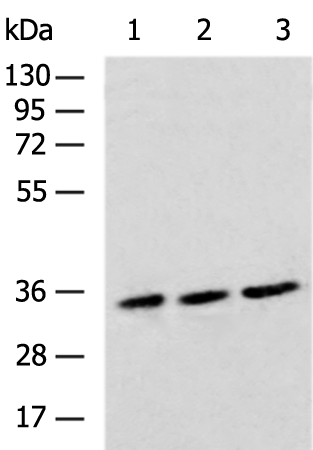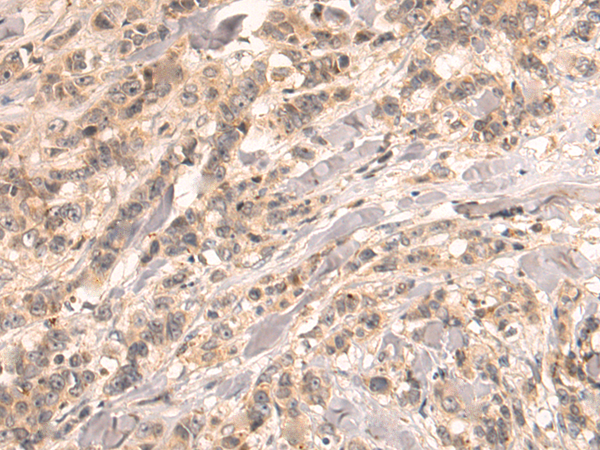

| WB | 1/500-1/2000 | Human,Mouse,Rat |
| IF | 咨询技术 | Human,Mouse,Rat |
| IHC | 1/50-1/200 | Human,Mouse,Rat |
| ICC | 技术咨询 | Human,Mouse,Rat |
| FCM | 咨询技术 | Human,Mouse,Rat |
| Elisa | 1/5000-1/10000 | Human,Mouse,Rat |
| Aliases | MOP; MOR; LMOR; MOR1; OPRM; M-OR-1 |
| WB Predicted band size | 44 kDa |
| Host/Isotype | Rabbit IgG |
| Antibody Type | Primary antibody |
| Storage | Store at 4°C short term. Aliquot and store at -20°C long term. Avoid freeze/thaw cycles. |
| Species Reactivity | Human, Mouse, Rat |
| Immunogen | Synthetic peptide of human OPRM1 |
| Formulation | Purified antibody in PBS with 0.05% sodium azide and 50% glycerol. |
+ +
以下是关于OPRM1抗体的3篇参考文献及其摘要概括:
1. **《Characterization of a novel antibody for μ-opioid receptor (MOR) detection in the mouse brain》**
*作者:Bardoni et al. (2014)*
**摘要**:该研究开发并验证了一种特异性识别小鼠μ-阿片受体(OPRM1)的新型抗体。通过免疫组织化学和Western blotting,证明该抗体可特异性标记小鼠脑组织中的OPRM1.且与δ/κ-阿片受体无交叉反应,为神经科学中的受体定位研究提供了可靠工具。
2. **《Comparative analysis of OPRM1 antibody specificity in the enteric nervous system》**
*作者:Poole et al. (2011)*
**摘要**:研究比较了多种市售OPRM1抗体在肠神经系统中的特异性。通过基因敲除小鼠模型,发现部分抗体在免疫荧光染色中存在非特异性结合,强调在肠道等复杂组织中验证抗体特异性的必要性。
3. **《Validation of commercial OPRM1 antibodies using CRISPR-Cas9 knockout models》**
*作者:Huang et al. (2020)*
**摘要**:利用CRISPR-Cas9技术构建OPRM1基因敲除细胞系,系统性评估了5种常用商业抗体的可靠性。结果显示仅两种抗体在Western blot和免疫组化中表现出高特异性,提示研究者需谨慎选择并验证抗体。
这些文献聚焦于OPRM1抗体的开发、特异性验证及在不同组织中的应用,为实验设计和抗体选择提供了参考依据。
The OPRM1 antibody targets the μ-opioid receptor (MOR), encoded by the *OPRM1* gene, which is a G protein-coupled receptor (GPCR) central to pain modulation, reward pathways, and addiction. MORs are primarily expressed in the central nervous system (CNS), peripheral neurons, and immune cells, mediating endogenous and exogenous opioid effects. OPRM1 antibodies are essential tools for studying receptor localization, expression levels, and signaling mechanisms in both physiological and pathological contexts. They are widely used in techniques like Western blotting, immunohistochemistry, and flow cytometry to explore MOR involvement in chronic pain, opioid tolerance, substance use disorders, and psychiatric conditions.
These antibodies vary by clonality (monoclonal/polyclonal), species reactivity (human, mouse, rat), and epitope specificity (extracellular, intracellular domains). Validation often includes knockout controls or blocking peptides to confirm specificity, as cross-reactivity with other opioid receptor subtypes (e.g., δ- or κ-opioid receptors) can occur due to structural homology. Additionally, post-translational modifications (e.g., phosphorylation, glycosylation) may influence antibody binding efficiency.
Research using OPRM1 antibodies has advanced understanding of genetic polymorphisms (e.g., *OPRM1* A118G SNP) affecting opioid efficacy and addiction susceptibility. However, challenges remain in standardizing antibody performance across experimental models, highlighting the need for rigorous validation in specific applications.
×